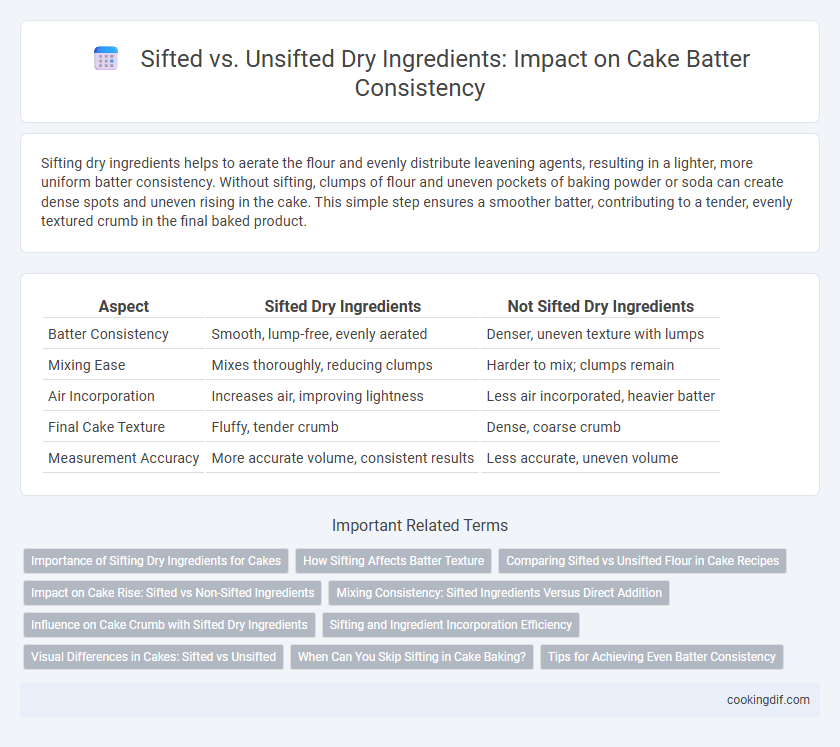Sifting dry ingredients helps to aerate the flour and evenly distribute leavening agents, resulting in a lighter, more uniform batter consistency. Without sifting, clumps of flour and uneven pockets of baking powder or soda can create dense spots and uneven rising in the cake. This simple step ensures a smoother batter, contributing to a tender, evenly textured crumb in the final baked product.
Table of Comparison
| Aspect | Sifted Dry Ingredients | Not Sifted Dry Ingredients |
|---|---|---|
| Batter Consistency | Smooth, lump-free, evenly aerated | Denser, uneven texture with lumps |
| Mixing Ease | Mixes thoroughly, reducing clumps | Harder to mix; clumps remain |
| Air Incorporation | Increases air, improving lightness | Less air incorporated, heavier batter |
| Final Cake Texture | Fluffy, tender crumb | Dense, coarse crumb |
| Measurement Accuracy | More accurate volume, consistent results | Less accurate, uneven volume |
Importance of Sifting Dry Ingredients for Cakes
Sifting dry ingredients such as flour, baking powder, and cocoa powder is crucial for achieving a light, uniform batter consistency in cakes. This process aerates the ingredients, eliminates lumps, and ensures even distribution of leavening agents, which promotes proper rising and texture. Neglecting to sift can result in dense cakes with uneven crumb structure and compromised moisture retention.
How Sifting Affects Batter Texture
Sifting dry ingredients aerates the flour and evenly distributes leavening agents, resulting in a lighter, smoother batter texture that bakes more uniformly. Unsifted ingredients can lead to denser, lumpier batter due to uneven mixing and retained clumps. Consistent sifting improves crumb structure by promoting better gluten development and moisture absorption throughout the batter.
Comparing Sifted vs Unsifted Flour in Cake Recipes
Sifting flour aerates and removes lumps, resulting in a lighter, more uniform batter that improves cake texture. Unsifted flour can cause denser, uneven crumb due to clumps and compacted particles, affecting rise and moistness. Precise sifting enhances ingredient integration, optimizing cake volume and smoothness in baked goods.
Impact on Cake Rise: Sifted vs Non-Sifted Ingredients
Sifting dry ingredients aerates flour and evenly distributes leavening agents, creating a lighter, fluffier cake with better rise. Non-sifted ingredients can lead to denser batter due to uneven mixing and potential lumps, resulting in a compact crumb. Consistently sifting ensures uniform texture and maximizes cake volume by preventing heavy spots in the batter.
Mixing Consistency: Sifted Ingredients Versus Direct Addition
Sifting dry ingredients aerates the flour and evenly distributes baking powder, baking soda, and salt, resulting in a lighter, more consistent batter texture. Without sifting, clumps may form, causing uneven mixing and dense spots in the cake. Properly sifted ingredients promote optimal gluten development and smooth batter consistency, enhancing the final cake's crumb and rise.
Influence on Cake Crumb with Sifted Dry Ingredients
Sifting dry ingredients such as flour, baking powder, and cocoa powder aerates the mixture, preventing clumps and ensuring even distribution of leavening agents, which results in a lighter, more uniform cake crumb. When dry ingredients are not sifted, denser batter with uneven pockets can form, leading to a heavier, coarse crumb texture. Consistently sifting enhances the final cake structure by promoting better gluten development and improved batter consistency.
Sifting and Ingredient Incorporation Efficiency
Sifting dry ingredients aerates the flour and evenly distributes leavening agents, resulting in a lighter, more consistent batter texture. Without sifting, ingredients can clump, causing uneven mixing and denser cake crumbs. Efficient sifting enhances ingredient incorporation, improving batter smoothness and final cake rise.
Visual Differences in Cakes: Sifted vs Unsifted
Sifted dry ingredients create a finer, lighter batter that leads to cakes with a smoother, more even crumb and a delicate, airy texture. Unsifted ingredients can cause denser cakes with visible lumps or uneven pockets, resulting in a coarser texture and less uniform rise. Visually, sifted batters produce cakes with a more consistent surface and softer appearance, while unsifted batters often yield cakes with rougher tops and irregular crumb structures.
When Can You Skip Sifting in Cake Baking?
Skipping sifting dry ingredients like flour, baking powder, and cocoa powder is possible when using pre-sifted or finely milled products, resulting in consistent batter texture with minimal risk of lumps. If recipes specify sifting to aerate ingredients and ensure even distribution, skipping may compromise the cake's lightness and rise, particularly in delicate sponge or chiffon cakes. For denser cakes like brownies or pound cakes, sifting is less critical, and avoiding sifting can save time without significantly affecting batter consistency.
Tips for Achieving Even Batter Consistency
Sifting dry ingredients aerates the flour, removes lumps, and ensures even distribution of baking powder or soda, resulting in a smoother batter and uniform crumb texture. When dry ingredients are not sifted, uneven mixing can cause dense spots and inconsistent rising during baking, affecting cake texture and appearance. For optimal batter consistency, always measure dry ingredients first, sift them thoroughly, and fold gently to maintain aeration and achieve a light, tender cake.
Dry ingredients sifted vs Not sifted for batter consistency Infographic

 cookingdif.com
cookingdif.com